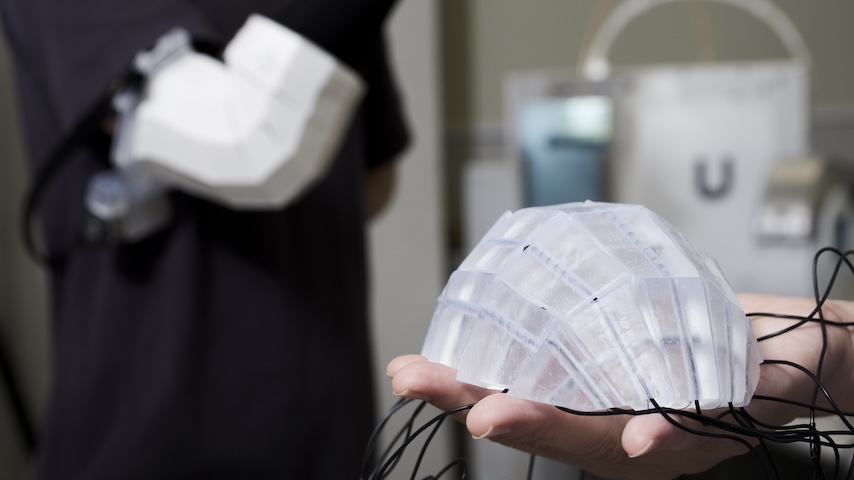3D-Printed Fabric Hardens and Softens on Command
3D-Printed Fabric Hardens and Softens on Command


A scale-inspired flexible fabric could be used for a variety of applications thanks to its ability to stiffen instantly.
Drawing inspiration from nature in the form of pangolins, armadillos, and fish, a team of researchers at Nanyang Technological University, Singapore has developed a new type of fabric that can harden and soften with the push of a button, thanks to some geometric design, 3D printing, and robotic controls.
Dubbed RoboFabric, it can be produced with virtually any 3D printer. “The idea is that we have 3D printed these tiles that are basically building blocks. We printed hundreds of them so they can form something like a sheet,” explained Yifan Wang, lead scientist and assistant professor at the NTU School of Mechanical and Aerospace Engineering.
Within and between these tiles are metal fibers, which connect the tiles to one another through tiny channels. This creates a soft material, similar to a textile or fabric, Wang said.
“The interesting part is when it is being actuated. We have a mechanism that is able to pull on these fibers to tighten them, so once these fibers are pulled together, they’ll form a rigid cast structure,” he continued.
These tiles act much like the scales of a pangolin, which interlock to form a shell. The mechanism is driven by an advanced mathematical algorithm that designed the tile system. When hardened, the rigidity of RoboFabric increases by more than 350 times.
Another benefit is the material is incredibly customizable, so when it’s activated, it will form to whatever shape is underneath—be it an elbow, wrist, or leg.
“One of the big challenges is that we have all these fibers running through these tiles—we made several hundred of them—so we had to figure out a specific strategy to connect these fibers to each other and to the motor that’s being used to pull them,” Wang explained. As for the motor, it weighs just a few hundred grams combined with the battery, so a user could easily wear it in a small pack on the waist or back.
A custom assist
The 10-person multidisciplinary team working on the project has already developed an elbow support that can help people carry heavier loads and a wrist support prototype that could help stabilize joints. According to the team’s findings published in Advanced Materials earlier this summer, human muscle activity can be reduced by up to 40 percent when an individual is using a support made from RoboFabric.
Discover the Benefits of ASME Membership
“The ultimate goal of this research is to create an assistive device that can be worn on the human body for protection and for some rehabilitation purposes,” Wang added. “If we look at past research on these types of robotic exoskeletons or assistive devices, you will notice that they are mostly made of rigid materials, such as metal components and electric motors. So one problem is that although they are quite functional, when you wear them, they don't really have a good conformability with the human body.”
Other attempts at similar devices also weigh users down, as metal components within them can be anywhere from several to tens of kilograms.
Wang first began working on the material when he was a postdoc at Caltech about five years ago. “We started on the very first version, which is a 3D-printed fabric that can be worn on the human body and stiffens by itself,” he said. “In this new work, what we have done is designed a customizable 3D-printed fabric or textile that you can wear on the body that also provides assistance at the same time.”
There are some similar attempts that have been driven by other mechanisms, such as a pneumatic pump, but those devices aren’t quite the same as this material, Wang continued, noting that RoboFabric may be the first of its kind.
Check This Out: Lunar Settlements Could Be Made from Fabric
The team aimed to develop a design strategy for the tiles and structures, so any 3D printer could produce the fabric—even a metal printer, he pointed out, making the design that much more versatile. It’s also greatly customizable, as the fabric could be made to fit any shape or size.
In another paper recently published in Science Robotics, Wang’s team also demonstrated a tiny robot made of thin waveshaped tiles sealed in an elastic envelope. When a vacuum is applied, the RoboFabric stiffens, then softens when the vacuum is removed. That action allowed the robot to climb like a worm or swim in water, carrying small loads or protecting an asset by forming a rigid shell.
Products ahead
While biomedical devices and soft robotics are the most obvious applications, RoboFabric could see use across a range of industries. Wang believes there could be potential for sports equipment in the form of helmets or braces, or in heavy industry, where some workers are already using certain types of exoskeletons to help save energy and reduce fatigue.
For now, a patent on the technology is now pending and the team is already in discussions with industrial partners who are interested in developing the fabric into a product for patients or the elderly, moving one step closer to commercialization.
Louise Poirier is senior editor.



